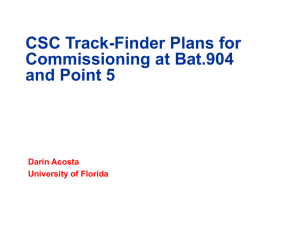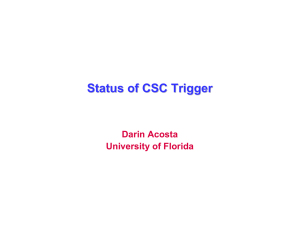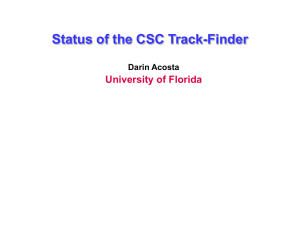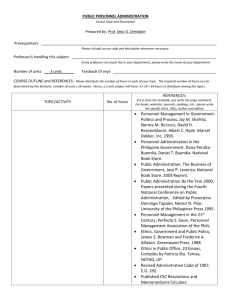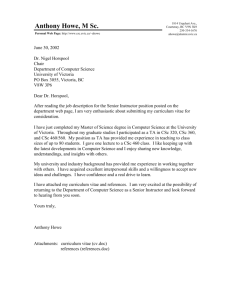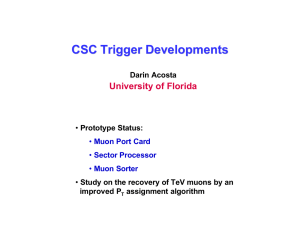CSC Track - Finder Report CSC Track-Finder Report
advertisement
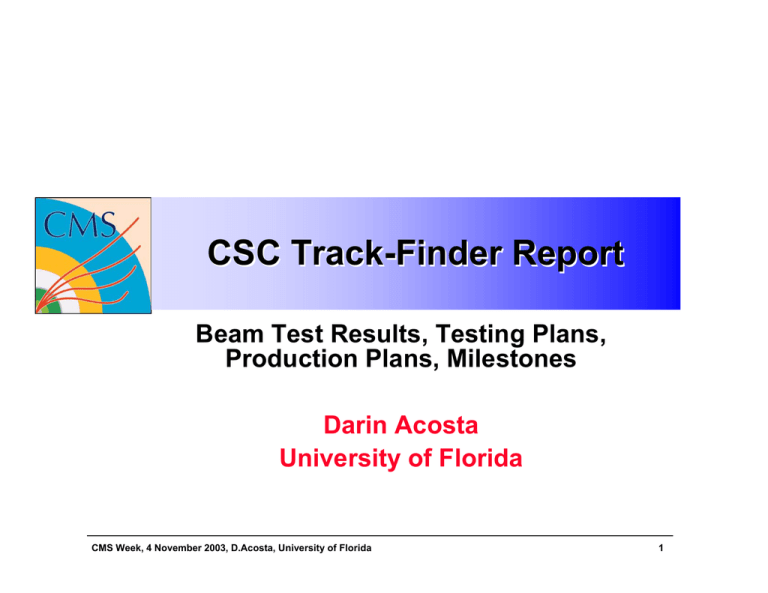
CSC Track -Finder Report Track-Finder Beam Test Results, Testing Plans, Production Plans, Milestones Darin Acosta University of Florida CMS Week, 4 November 2003, D.Acosta, University of Florida 1 The Level -1 Filter Level-1 Note: We should rename our project (at least in the U.S.) “Trigger” has politically incorrect connotations, and can lead to a visit from the F.B.I. to check on what you are doing… So, the Track-Finder should be considered a part of the CMS Level-1 Filter electronics CMS Week, 4 November 2003, D.Acosta, University of Florida 2 CSC Track -Finder Crate Track-Finder MPC, for in-crate tests CCB with TTCRx Sector Processor, receives optical data Second generation prototypes tested at beam test CMS Week, 4 November 2003, D.Acosta, University of Florida 3 CSC Track -Finder (SP) Trigger* Track-Finder Test 3 × 1.6 Gb/s optical link connections from CSC electronics Home-built VCXO & PLL clock patch added to clean incoming TTC clock for links, but TTC QPLL also tested Uses TLK2501 chipset from TI Requires very stable reference clock for errorfree operation Errors during May tests without PLL * Filter CMS Week, 4 November 2003, D.Acosta, University of Florida 4 Data -taking Mode Data-taking Most data logged using two independent DAQ systems: • • “CFEB Control” for CSC detector data and front-end trigger “SP DAQ” for Track-Finder data (standalone SP readout) • SP records 5 BX of input data for each L1A, with most trigger data arriving on central BX • Allows study of time-dependence of trigger data XDAQ-based event builder also able to log data • • Underlying SP code the same as for standalone DAQ since it was written using XDAQ All analysis of SP and DDU data from either DAQ system is done using the XDAQ-based software CMS Week, 4 November 2003, D.Acosta, University of Florida 5 Data Comparison CSC Data from DAQ CSC 1 CSC Track-Finder Data CSC 2 CMS Week, 4 November 2003, D.Acosta, University of Florida 6 Detailed TMB –SP Comparison TMB–SP Run TMB data (correlated LCT trigger primitives) through MPC simulation to compare with SP • • • MPC is not directly read out MPC sorts possible 4 LCTs to 3 in beam test data Use BXN reported by ALCT for each LCT Preliminary comparison between SP and TMB for all 5 BX read out by SP for every L1A match: • 99.7% agreement for ~70K events Mismatches between TMB and SP data are in BX assignment only, not in LCT frames • More detailed checks will continue CMS Week, 4 November 2003, D.Acosta, University of Florida 7 Correlated LCT Efficiency abs(wg3-wg8) abs(strip3-strip8) abs(strip3-strip8) abs(wg3-wg8 The efficiency to identify a correlated LCT (ALCT+CLCT) in one csc in a straight-line path from an LCT found in the other csc (within a ±5 strip and ±3 WG tolerance) is: • 97.9% in one BX • 98.9% in two BX (correct BX or one after) • 99.1% in three BX (correct BX ±1) as determined from logged Track-Finder data CMS Week, 4 November 2003, D.Acosta, University of Florida 8 Correlated LCT Efficiency: timing Efficiency for the middle BX (BX#2) vs. ALCT delay time (for CSC#8) Efficiency for multi-BXs vs ALCT delay time (for CSC#8) efficiency efficiency 1.2 1 0.8 0.6 0.998 BXs: 1,2,3 0.997 0.996 0.995 0.994 0.4 Note the scale 0.2 0 0 5 10 1 BX Window: 15 20 delay, ns 0.993 0.992 BXs: 2,3 0.991 0.99 0 5 10 15 20 delay, ns • Efficiency sensitive to ALCT delay (~5ns window) Multi-BX Window: • Efficiency very close to 100% • Less sensitive to exact ALCT timing • No spatial requirement on shown efficiencies CMS Week, 4 November 2003, D.Acosta, University of Florida 9 CSC Trigger Latency Measured with scope during the beam tests: • From CSC to MPC input: • From the CSC to SR/SP input: (includes 100 m fiber, 18 bx delay) 32 bx (± 1 bx) 57 bx Estimated latency for output of SP: • Add 10 bx for SR/SP processing: 67 bx Estimated latency for output of Muon Sorter: • Add 7 bx for backplane + sorting: 74 bx Total compares well with 74.5 bx projected in TDR (Latter includes 1 bx TOF delay) Expect to save additional ~7 bx with Virtex-2 TMB Estimated latency to send CSC data to DT TF: • 57bx + 4bx for SR + 2bx cable +1bx TOF: 64 bx – 7 bx = 57 bx • Nearly aligned with DT data at DT TF: 54 bx according to TDR • At what bx will CSC TF receive DT data? CMS Week, 4 November 2003, D.Acosta, University of Florida 10 SP Tests Completed MPC→SP optical link tests • Demonstrated to work in April in single crate using crystal-oscillator clock (~1 error/hour) Optical Link tests with TTC • Demonstrated to work error-free during September beam test with home-built PLL+VCXO and with latest QPLL (TTCRq) DT/CSC Data Exchange Test • Demonstrated to work during September in both directions, with only a few minor problems with swapped bits, connectors, and dead chips • Repeat with longer cables and Track-Finding tests • See talk by J.Ero CMS Week, 4 November 2003, D.Acosta, University of Florida 11 Remaining SP Tests SP ↔ Muon Sorter, Part 1, 10/20/03 – 12/1/03 • Verification of data transmission from SP FIFO to MS FIFO through backplane at 80 MHz, including read-back of MS winner bits • PT LUTs bypassed • Status: SP output verified, sent to Rice for tests • Also important to verify SP communication from all possible SP slots! (tests backplane and mezzanine card I/O) SP Track-Finding Logic Test, 11/3/03 – 1/5/04 • Verification of TF logic on SP mezz. card with C++ model • Input and output FIFOs on same mezz. card • Status: need to finalize firmware and prepare software SR LUT Test, 11/10/03 – 1/5/04 • Verification of the reading & writing to SR LUTs on SP main board and validation of 40 MHz performance CMS Week, 4 November 2003, D.Acosta, University of Florida 12 Remaining SP Tests Cont’d PT LUT Test, 12/1/03 – 1/5/04 • Verification of the reading & writing to PT LUTs on SP main board and validation of 40 MHz performance Complete SP functionality test, 1/5/04 – 1/19/04 • “Chain test” of all onboard SP logic: Front FPGAs, SR LUTs, SP logic, PT LUT, with comparison against simulation SP ↔ Muon Sorter, Part 2, 1/19/04 – 2/2/04 • Repeat of verification of data transmission from SP FIFO to MS FIFO with PT LUTs included SP ↔ DDU (CSC DAQ board) Tests, Part 1, 2/2/04 – ? • Probably will be postponed because DDU design is changing and because of the significant firmware changes required on DDU board CMS Week, 4 November 2003, D.Acosta, University of Florida 13 Other Interesting Tests Multiple MPC ↔ SP Test • Could be done any time we have several MPC’s in TF crate • Verify correct synchronization between multiple boards (even better would be to have several peripheral crates…) SP ↔ SP Test • Stress-test of all 15 trigger links on SP: one SP as data-generator and one SP in normal mode • Could be done anytime Multiple SP ↔ MS Test • Verify correct transmission, timing, and read-back from multiple sources • Could be done once single SP ↔ MS test validated Cosmic-Ray and Beam Tests (2004) • Complete chain-test with detectors and fully functioning SP and MS • Demonstrate self-triggering DT/CSC Integration test, Part 2 • Demonstrate track-finding with exchanged data CMS Week, 4 November 2003, D.Acosta, University of Florida 14 Production and Test Plans Will assemble 1 board first as pre-production prototype and test before launching full production (12 SR/SP + 3 spare) • Not likely to occur before Trigger ESR in May’04, though Each of the prototype tests (optical link PRBS tests, LUT tests, etc.) will become standard tests for the production modules • Therefore, we will have a suite of tests in our XDAQ-based software (hopefully with a JAVA interface) • Initial testing will be performed by a technician or student • Encountered problems will be addressed by our engineers CMS Week, 4 November 2003, D.Acosta, University of Florida 15 CSC Track -Finder Milestones Track-Finder • • • • • • TF Backplane Proto tested Sep-02 Delay: Dec-03 SR/SP Prototype tested Mar-03 Delay: Feb-04 TF Backplane Prodn started Jul-04 SR/SP Production started Jul-04 TF Backplane Prodn done Mar-04 Delay: Jan-05 SR/SP Production done Jun-04 Delay: Jan-05 CMS Week, 4 November 2003, D.Acosta, University of Florida 16 Muon Sorter D D U SR SR SR SR SR SR / / / / / / SP SP SP SP SP SP DAQ interface MS CCB Clock and Control Board SBS 620 Controller CSC Track -Finder Crate Layout Track-Finder SR SR SR SR SR SR / / / / / / SP SP SP SP SP SP Sector Processor From MPC (chamber 4) From MPC (chamber 3) From MPC (chamber 2) From MPC (chamber 1B) From MPC (chamber 1A) To DAQ Front-panel: 12×16 (SP) + 12 (DDU) + 1 (TTC) optical link inputs 4 LVDS SCSI connectors output (MS) Back-plane (trans. cards): 12×6 SCSI connectors (SP) to/from DT CMS Week, 4 November 2003, D.Acosta, University of Florida 17 Custom GTLP backplane VME and Custom Backplane • Standard 9U VME crate and power (including 3.3V) CMS Week, 4 November 2003, D.Acosta, University of Florida 18 CSC Track -Finder Rack Layout Track-Finder In principle, the entire CSC Track-Finder fits into one rack (one crate) Should be close to DT Track-Finder and Global Trigger: CMS Week, 4 November 2003, D.Acosta, University of Florida 19 Conclusions CSC beam test with Track-Finder was a success! • Complete electronic chain test of synchronous data transmission from CSC front-end electronics to the Track-Finder • Latest QPLL design from CERN tested and works Initial tests show that DT and CSC TrackFinders can exchange data • A few minor problems on both ends with swapped bits, connectors, and dead chips Remaining Track-Finder tests underway • Some delay, but production should complete in early 2005 CMS Week, 4 November 2003, D.Acosta, University of Florida 20
